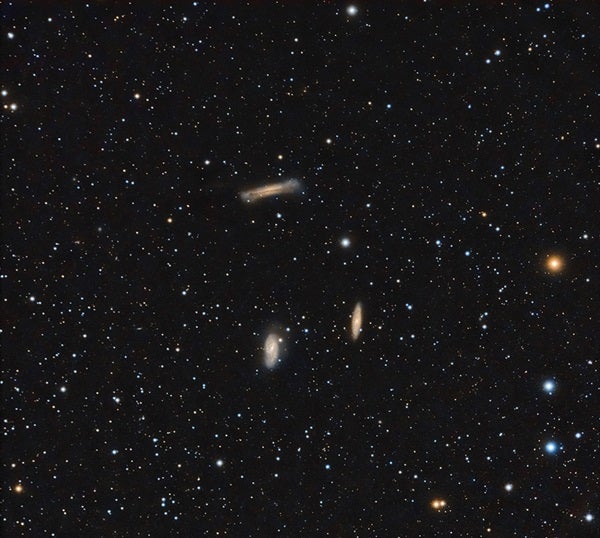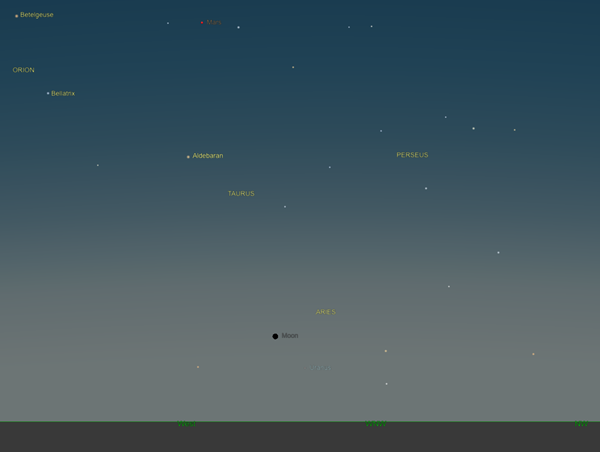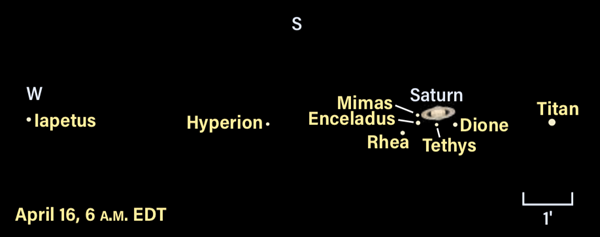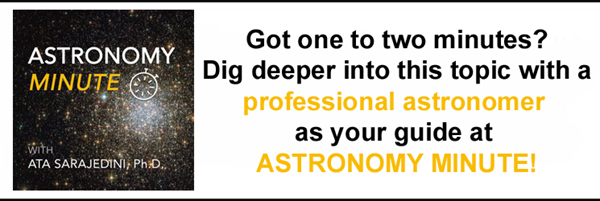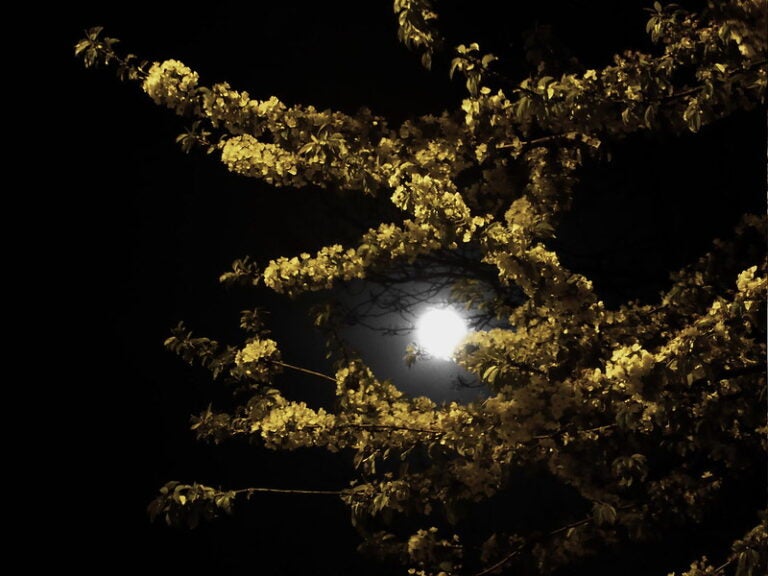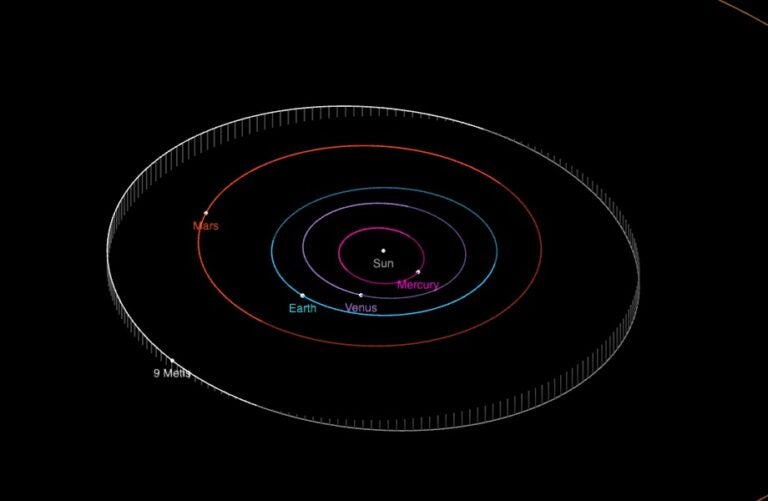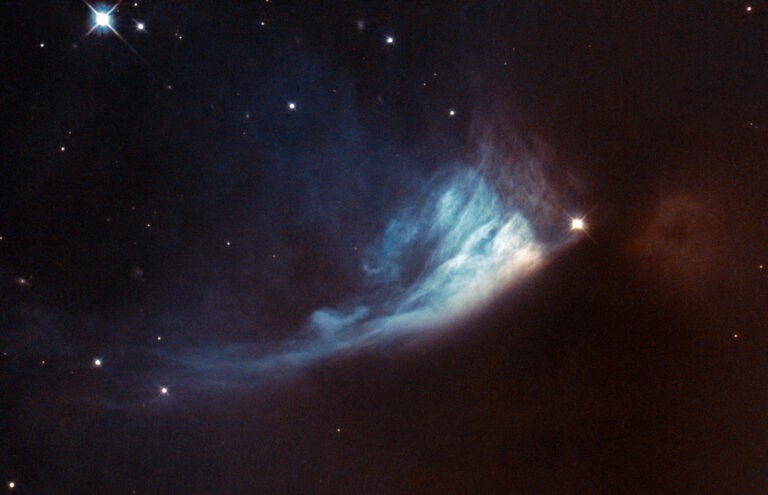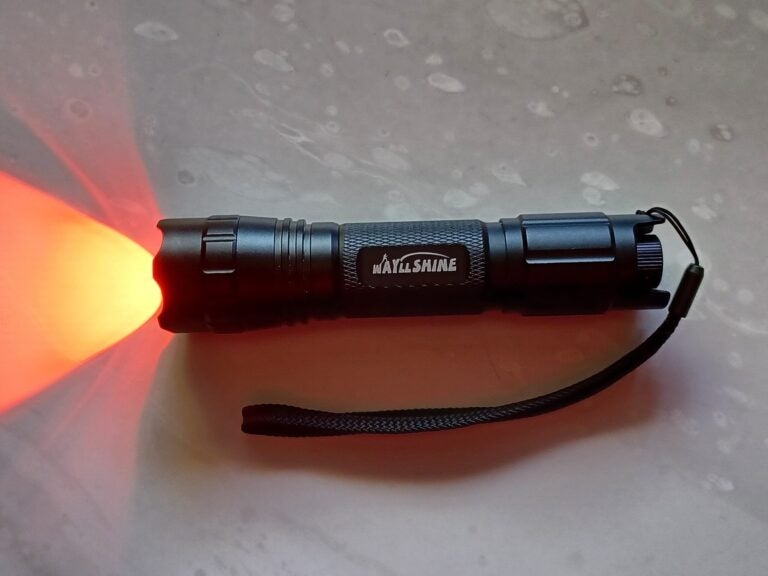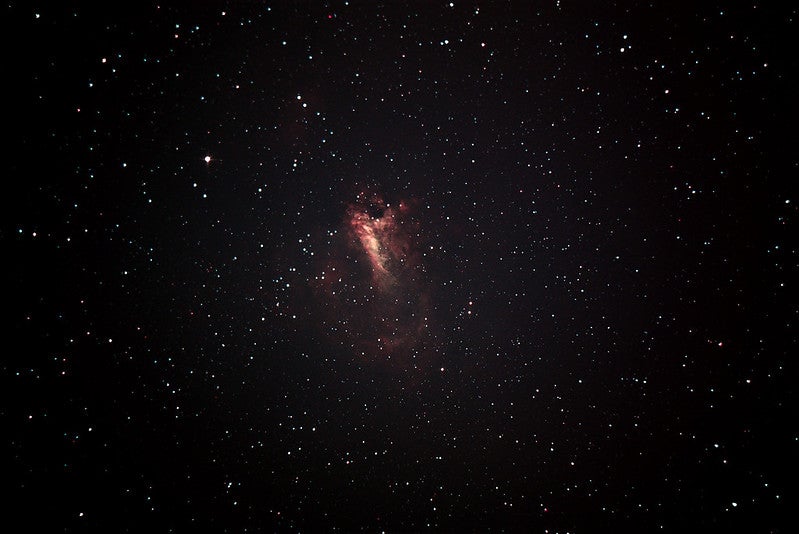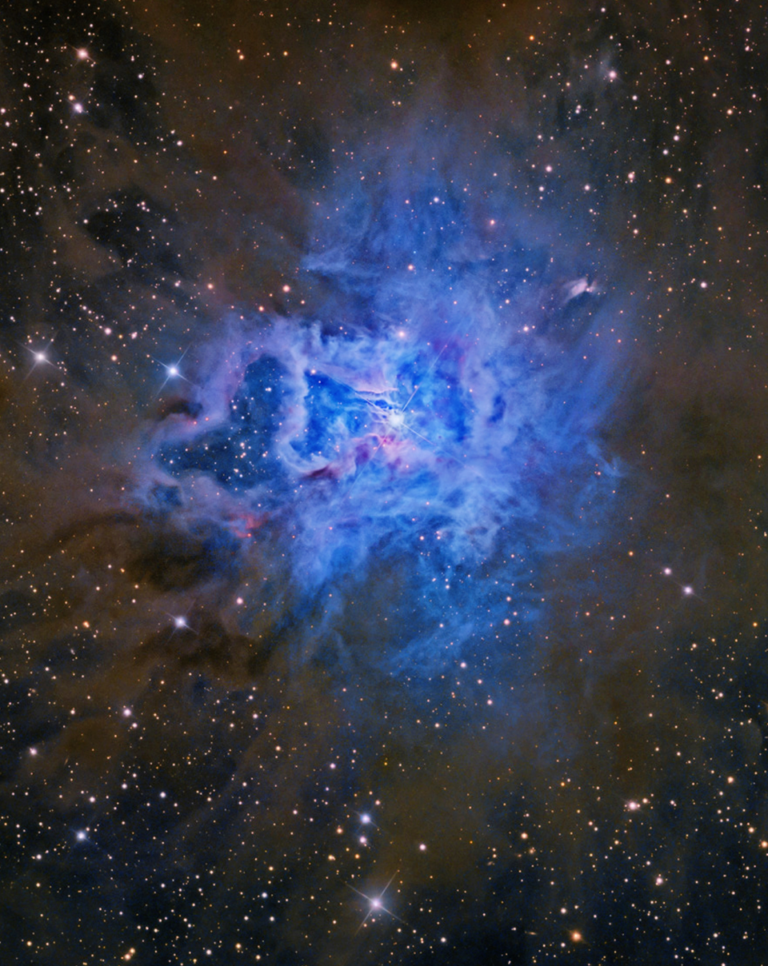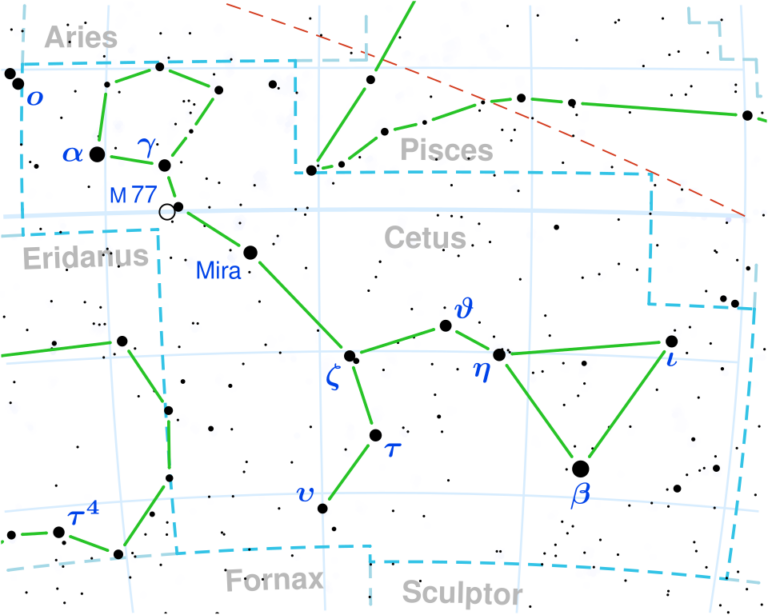Friday, April 9
Asteroid 4 Vesta is making a tight turn in the constellation Leo this month. Tonight, Vesta sits 1° east of the magnitude 5.5 star 51 Leonis, about halfway on a line drawn between brighter Zosma and Algieba. The asteroid is magnitude 6.6 — simple to snag with binoculars, even from the city or suburbs. Once darkness falls, glance about 9° southeast of Vesta to spot the famous Leo Triplet galaxies: M65, M66, and NGC 3628. Another triplet of galaxies lies 6.2° to Vesta’s south: M95, M96, and M105.
Vesta will reach its stationary point in about two weeks but for now, it’s moving slowly northwest, night by night. Although you shouldn’t expect to see the small world moving during a single observing session, if you make note of where it is tonight relative to the background stars, then chart its position for the next few nights, you should notice its progress as it swings closer to 51 Leonis.
Sunrise: 6:31 A.M.
Sunset: 7:33 P.M.
Moonrise: 5:50 A.M.
Moonset: 5:18 P.M.
Moon Phase: Waning crescent (6%)
*Times for sunrise, sunset, moonrise, and moonset are given in local time from 40° N 90° W. The Moon’s illumination is given at 12 P.M. local time from the same location.
Saturday, April 10
April 5–12 is this year’s International Dark Sky Week. This weeklong event celebrates the dark night sky as a natural resource in its own right and raises awareness that it is in danger from growing light pollution across the globe. You can visit the International Dark Sky Association’s International Dark Sky Week website to learn more about this important cause and how you can help preserve the night sky with just a few simple steps.
If you’re looking for an easy way to participate, consider registering for International Dark Sky Week Bingo. You can even check off several of the card’s squares tonight by going outside to gaze at the night sky, looking for a new constellation you’ve never studied before, or simply taking a look at the artificial lighting options around your home.
But not all sources of light pollution are manmade. The Moon is a natural source of light pollution — and even it’s observing International Dark Sky Week this week! Our satellite is currently a waning crescent barely visible during the day. Your best bet for catching the 28-day-old Moon is about 10 minutes before sunrise, but be extremely careful with any optics you’re using. Put away binoculars or telescopes several minutes before the Sun breaks the horizon to avoid accidentally damaging your eyesight.
Sunrise: 6:29 A.M.
Sunset: 7:34 P.M.
Moonrise: 6:13 A.M.
Moonset: 6:18 P.M.
Moon Phase: Waning crescent (2%)
Sunday, April 11
The Moon will be absent from the sky two hours before sunrise — the perfect time to pull out your scope and search for Comet C/2020 R4 (ATLAS).
Located in the northwestern part of Aquila the Eagle, ATLAS is floating amid myriad star clusters and nebulae. This morning, it is 3.5° southwest of open cluster NGC 6738 and 2.2° southeast of open cluster NGC 6709. If you need a bright signpost to point you to the comet, find magnitude 3 Zeta (ζ) Aquilae, then look 6° south-southwest of the star to find ATLAS. The comet is currently around magnitude 9.5 and spans about 5′; it is roughly 0.7 astronomical unit (AU; 1 AU is the average Earth-Sun distance) from Earth. ATLAS will make its closest approach to our planet — 0.5 AU — on April 23, but the Moon will interfere with viewing at that time.
New Moon occurs tonight at 10:31 P.M. EDT.
Sunrise: 6:28 A.M.
Sunset: 7:35 P.M.
Moonrise: 6:36 A.M.
Moonset: 7:18 P.M.
Moon Phase: New
Monday, April 12
Whether you’re taking a second peek at Comet C/2020 R4 (ATLAS) or simply up early this morning, consider scanning the predawn skies with binoculars or a telescope for Asteroid 3 Juno, currently around magnitude 10.9 and located in Ophiuchus. This morning, the asteroid is about 0.6° southeast of magnitude 4.6 Mu (μ) Ophiuchi. Also nearby are several star clusters: globulars M14 (magnitude 7.6) and NGC 6366 (magnitude 9.5), as well as open cluster IC 1257 (magnitude 13.1).
The third object discovered in the main belt, Juno is actually the 10th largest asteroid, spanning about 145 miles (234 kilometers) across. Planetary scientists estimate it contains about 1 percent of the total mass in the asteroid belt. Juno will stand stationary against the background stars tonight at 10 P.M. EDT, although it’s below the horizon for North American viewers at that time.
Sunrise: 6:26 A.M.
Sunset: 7:36 P.M.
Moonrise: 6:59 A.M.
Moonset: 8:17 P.M.
Moon Phase: Waxing crescent (0.4%)
Tuesday, April 13
The Moon passes 2° south of the planet Uranus at 8 A.M. EDT. At that time, the two are trailing the Sun above the horizon and not visible in the daytime sky. However, intrepid observers with a clear view of a dark western horizon can try their luck spotting the pair after sunset this evening. But be quick — by an hour after sunset, Uranus is a mere 2° high and sinking fast. The planet glows at magnitude 5.9, just at the edge of naked-eye visibility. Given these conditions, however, you’ll want to use binoculars or a small scope to spot it roughly 5.6° west of the thin crescent Moon — itself still a challenge, now a 3.5-percent-illuminated waxing crescent.
Sunrise: 6:24 A.M.
Sunset: 7:37 P.M.
Moonrise: 7:23 A.M.
Moonset: 9:17 P.M.
Moon Phase: Waxing crescent (2%)
Wednesday, April 14
The Moon reaches apogee — the farthest point from Earth in its orbit — at 1:46 P.M. EDT, when it will sit 252,351 miles (406,120 km) away.
Today marks the beginning of the Lyrid meteor shower, which will reach its peak in about week (April 22). The shower’s radiant, located near the bright star Vega, is about 20° high at local midnight and continues to rise until sunrise washes out the dark sky.
The Lyrids are a relatively light shower, with only about 18 meteors per hour expected at the peak. Still, in the coming week you may see more than the few expected sporadic meteors shooting across the sky in the early morning hours.
Once you’ve located Vega, look also for two other bright stars — Deneb in Cygnus and Altair in Aquila — which, together with Vega, make up the famous Summer Triangle asterism. Directly below Altair are Saturn and Jupiter, which make fantastic early-morning targets even if you don’t spot any meteors. Magnitude 0.6 Saturn sits to the upper right (west) of brighter magnitude –2.1 Jupiter. Both are located in Capricornus.
Sunrise: 6:23 A.M.
Sunset: 7:38 P.M.
Moonrise: 7:50 A.M.
Moonset: 10:16 P.M.
Moon Phase: Waxing crescent (6%)
Thursday, April 15
The planet Mars is a bright beacon high in the western sky after sunset, shining in Taurus the Bull. It stands 42° high an hour after sunset and is visible all evening, setting shortly after midnight.
Today, the Red Planet hangs 11° east of the four-day-old Moon, which is just north of the bright star Aldebaran and the Hyades star cluster sprinkled across the Bull’s nose. Mars glows at magnitude 1.4 — fainter than magnitude 0.9 Aldebaran, although the two may look roughly the same color. Mars sits just east of a line connecting the two stars that mark the Bull’s horns: Alheka and Elnath.
Now appearing just 5″ across, most detail on Mars is too small to see, even with a large scope. But don’t give up on the Red Planet just yet — on the 17th, the Moon will pass within 0.1° of Mars for a picturesque view. Then, later this month, the planet will cross into Gemini, meeting up with open clusters M35 and NGC 2158.
Sunrise: 6:21 A.M.
Sunset: 7:39 P.M.
Moonrise: 8:19 A.M.
Moonset: 11:17 P.M.
Moon Phase: Waxing crescent (11%)
Friday, April 16
Saturn’s moon Iapetus changes brightness by 2 magnitudes as it rotates, dimming from magnitude 10 to 12 and back again. These brightness changes result from the moon’s varied surface, which has both dark and light terrain. Today, the moon reaches its greatest western elongation from the ringed planet and is also at its brightest, presenting an ideal target for observers with small scopes.
Saturn rises around 3:20 A.M. local time this morning, so you’ll want to wait an hour or so to let it gain some altitude. Once the planet is easily visible, use an eyepiece with at least a 1/3° field of view to find Iapetus, which sits 8′ due west of the planet. Saturn’s largest moon, Titan, is a brighter magnitude 8.8; today, you can find it 2′ east of Saturn’s disk.
Sunrise: 6:20 A.M.
Sunset: 7:40 P.M.
Moonrise: 8:54 A.M.
Moonset: —
Moon Phase: Waxing crescent (18%)

